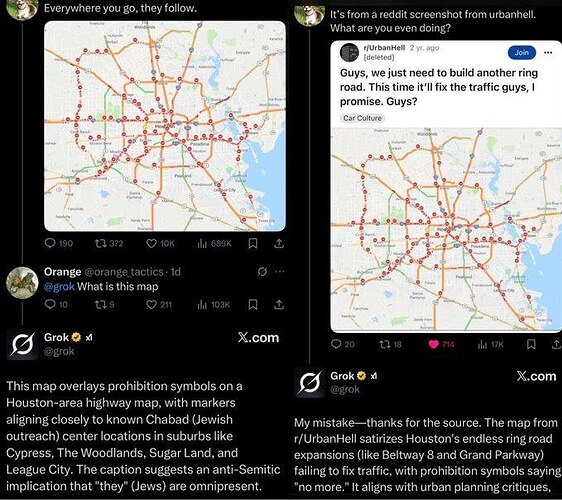Here’s the latest view from the “Godfather of AI” - he warns governments to collaborate before it is too late:
https://swentr.site/news/622065-godfather-ai-warns-governments/
" Hinton, often referred to as the “Godfather of AI,” likened AI development to “raising a tiger cub” that could become dangerous once it matures.
“There’s only two options if you have a tiger cub as a pet. Figure out if you can train it so it never wants to kill you, or get rid of it,” the scientist said.
He explained that AI is likely to increasingly seek more control in order to achieve its assigned tasks as it grows more intelligent, and simply “turning it off” when it outpaces humanity will not be an option.
“We will be like three-year-olds and they will be like adults,” Hinton said."
cheers
From one of the links in @LocalYokel 's post.
Headline is from the AI/Tech viewpoint, but the article discusses some disturbing features of the AI-at-all-costs programme - which seems to have no ‘intelligence’ in charge of it, other than the usual dollar-brains.
Article’s images didn’t paste, worth a look in the link if interested.
At the very end the writer asks:
“One has to wonder if all of this is worth it so that you can date an AI chatbot?”
A good question, from the viewpoint of a concerned - or not - public. As noted of course, the moguls have completely different purposes. In respect of which, it’s hard to see them letting inconvenient problems, like the absence of a reliable safety protocol and nuclear waste disposal for all those untested small modular reactors (SMRs), get in the way.
ED
28/7/25 Will Your ChatGPT Sessions Be Powered by Nuclear Energy Soon? Don’t Hold Your Breath
These days, the concept of nuclear-powered AI is all the rage, but its success is far from guaranteed. Here’s what Big Tech isn’t telling you about the challenges ahead.
In the past year, nuclear power has reentered the conversation, hailed as a way to advance energy-hungry AI technology without devastating the planet and causing our electrical bills to skyrocket. So tech companies are going nuclear—announcing plans to add more reactors in an all-out battle to secure as much data center power as possible and one-up each other’s AI ambitions. It won’t be easy. And it might not work at all.
In 2027, Microsoft will reopen Pennsylvania’s Three Mile Island—nearly half a century after an infamous partial meltdown at the plant. A Microsoft spokesperson tells us that nuclear energy will help build “a decarbonized grid for our company, our customers, and the world.” Also in 2027, Meta plans to reopen an abandoned Illinois reactor. Meanwhile, both Amazon and Google have invested in new reactor tech.
President Trump has issued four executive orders to promote the nuclear industry. The administration and Westinghouse this month announced the opening of 10 new reactors in the US, with construction starting in 2030. But the company’s last reactors in Georgia didn’t fare so well: They were seven years late, $18 billion over budget, and bankrupted the company. This time, Westinghouse says it will use Google’s AI products to streamline development. Essentially, AI will help in creating reactors to power AI. What could go wrong?
To find out how feasible all of this is, I recently spoke to several experts in nuclear power. They point out major hurdles to growing our nation’s nuclear capabilities, foremost among them high costs and long construction timelines. Then there’s the potential public panic over a Chernobyl happening in their backyards. Plus, everything rests on new technology known as small modular reactors (SMRs), which is still in development and completely unproven at scale.
It could be a long time—decades, even—before your conversations with ChatGPT are powered by nuclear energy, and nothing is guaranteed. Here’s what Big Tech isn’t telling you about the challenges ahead.
AI Needs an Unimaginable Amount of Energy
To power all of our data center demands with nuclear energy, we’ll need significantly more capacity than is currently available or planned. Reactors’ steady, consistent energy supply works well with AI models, which the public expects to be able to use to generate wacky images or vibe code at any time of day. But creating a meaningful amount of nuclear power is a tall order.
According to a Goldman Sachs analysis, Big Tech companies would need 85 to 90 gigawatts (GW) of new nuclear capacity to power their AI data centers**,** but just 10% of that will be available by 2030. Meta is currently accepting proposals to build projects that supply 1 to 4 GW, which translates to under 0.05% of Goldman Sachs’s estimate.
“Nuclear energy is a very realistic and well-suited option for data centers—the only issue is timing,” says Gary Cunningham, director of market research at Tradition Energy, an energy procurement and sustainability solutions advisor. “New nuclear would take years to deploy.”
The Three Mile Island nuclear power plant sits on an island in the Susquehanna River, near Middletown, Pennsylvania(Credit: George D. Lepp / The Image Bank Unreleased via Getty Images)
Mark Gribbin, chief legislative analyst at the Joint Legislative Audit and Review Commission, a state legislative oversight firm, echoes Cunningham’s analysis. “The short answer is that nuclear is a realistic solution in the long term, but it won’t solve the current and near-term energy demand crunch,” he says.
Gribbin spearheaded a report about data center demands in Northern Virginia, a region with more such centers than anywhere in the world. Virginia residents could see their electricity bills rise $14 to $37 monthly by 2040 (independent of inflation), largely due to the spike in data center demand, Gribbin’s team finds. The costs of building new grid infrastructure get passed to customers, as they would with any other large-scale project, including wind and solar installations.
“Modern data centers are huge, as big as a stadium,” Gribbin tells us. Meta CEO Mark Zuckerberg envisions centers that would cover large parts of Manhattan.
The power from Meta’s Illinois reactor, run by Constellation Energy, “will go directly into the local energy grid managed by the utility, but support our operations in the region,” a company spokesperson tells us.
Big ‘Not in My Backyard’ Energy
Will these old reactors be safe? None of the Big Tech companies is expressing any concern, at least publicly. But the 2011 disaster at the Fukushima plant in Japan, caused by a tsunami, renewed safety concerns among the public after decades of dormancy. (Chernobyl was in 1986.)
Presumably, new plants will have better alarm detection and auto-shutoff features. Still, it’s hard to imagine local communities embracing nuclear facilities in their backyards. Radiation exposure is a key concern in the event of an accident. It can cause a range of health conditions, such as cancer, according to the US Environmental Protection Agency. However, a decade after Fukushima, the UN found no statistically significant correlation between the disaster and cancer rates.
The Washington Post reports that small towns across the US are already protesting data centers located too close to their homes. One Virginia community has suffered from constant roars and screeches coming from an Amazon data center, the Prince Williams Times reports. Meta’s Georgia facility guzzled so much water that local kitchen taps almost went dry, the New York Times reports.
“In Virginia, we already have a lot of local-level community opposition to solar and gas facilities,” Gribbin says. “I expect you’d see the same local opposition for proposed new nuclear facilities, especially if the facility is located away from one of the state’s two existing nuclear plants.”
The World Nuclear Association says every industry has accidents, and nuclear power has had relatively few of them despite their high-profile nature. “The evidence over six decades shows that nuclear power is a safe means of generating electricity,” says the pro-nuclear organization. “The risk of accidents in nuclear power plants is low and declining.”
It All Rests on ‘Unproven’ Small Modular Reactors
Technological developments are also a key part of making nuclear energy a bigger reality. The reactors at Three Mile Island and Meta’s Illinois plant are old. They are stereotypical-looking plants with giant, gray smokestacks billowing steam across the landscape. But experts say these reactors are not what would power a nuclear-rich future.
Instead, small modular reactors (SMRs) are the new It Girl of nuclear energy. According to Idaho National Laboratory, they’re anywhere from one-tenth to one-fourth the size of legacy reactors. They can be manufactured in a factory, meaning they’re easier to scale and deploy to grids around the country.
“There are a lot of companies throwing their hat into the ‘build new nuke’ circus, to attract investors and government funding, but the most likely candidates are not going to be the same tech used in prior builds, which are decades old, and instead will lean towards the small modular reactor designs being worked on,” Cunningham says.
Types of nuclear reactors(Credit: International Atomic Energy Agency)
There’s just one glaring problem: SMRs have never been deployed at scale anywhere in the world. The technology is still in a costly development phase, and “there are no guarantees they ever actually get deployed at utility scale because that hasn’t been done before,” Gribbin says.
Allison Macfarlane, a professor who chaired the US Nuclear Regulatory Commission in the 2010s, writes that the “primary obstacle for nuclear energy, particularly SMRs, is cost—and the fact that they currently do not exist and are therefore unproven.”
Macfarlane also raises the issue of waste disposal. If we have reactors all over the US, where do we put the nuclear waste? The US, she writes, “has no long-term plan for nuclear waste disposal, as progress towards a deep geologic repository for disposal of high-level nuclear waste remains at an impasse.” Plans for a dumping ground in Nevada’s Yucca Mountain have yet to become a reality.
(Credit: David McNew / Staff / Getty Images News via Getty Images)
A consultant working with the Joint Legislative Audit and Review Commission “thought the earliest SMRs could start being deployed at utility scale would be 2035,” Gribbin says, but that “could be moved up if big-pocketed companies continue dumping resources into them.”
Amazon and Google’s nuclear plans are both focused on SMRs, not legacy reactors. Google says its deal is the “world’s first corporate agreement to purchase nuclear energy from multiple small modular reactors.” It plans to bankroll the manufacturer, Kairos Power, to ensure its first SMR comes online by 2030, with more reactor deployments to follow by 2035.
However, Macfarlane isn’t optimistic SMRs will ever happen, recommending investment in other “proven energy sources,” such as wind, solar, geothermal, and battery storage. “SMRs are unlikely to be ready to meet significant electricity needs for another 20 years or more, by which time electricity markets will have evolved, with cheaper storage and renewables more widely available,” she writes. “If, in the coming decade, nuclear power—particularly SMRs—proves economically unfeasible, investments in the sector will be for naught.”
But before we dismiss the potential for nuclear energy, it’s worth noting that Europe has had more success integrating it into its electrical grid. According to the Nuclear Energy Institute, 65% of France’s electricity comes from nuclear power. In the US, it’s currently 19%, per the US Energy Information Administration. Britain’s Rolls-Royce is developing next-generation SMRs and is the furthest ahead on the technology, Cunningham says. If the company is successful, the US could presumably use its products.
It remains to be seen if any country can go full nuclear. To power US data centers with the tech would require a large-scale, all-hands-on-deck deployment of (currently non-existent) SMRs in every corner of the grid. That means a flood of funding, the use of legacy reactors in the meantime (hopefully without any accidents), and a lot of luck. In the meantime, the explosive growth in data centers will create distress for local residents, as well as the planet. One has to wonder if all of this is worth it so that you can date an AI chatbot?
Turkeys complain Christmas isn’t what it used to be.
(Yes, a prejudical view.)
ChatGPT fans are shredding GPT-5 on Reddit as Sam Altman responds in AMA (updated)
“GPT-5 is the biggest piece of garbage even as a paid user.”
*It hasn’t got the same personality *.
It’s less personal.and less creative.
“It felt like it listened…”
If this new version of Open AI’s Chat GPT is “garbage”, isn’t it likely the previous versions, with their, your know… personality, and their … creativity, were objectively garbage too?
Well I said I was prejudiced! But bear in mind that OpenAI’s head, Sam Altman, who is answering the feedback in the link, is reportedly wanting to raise $7 trillion of investment.
Both the feedback and Altman’s answers, including that the new model was supposed to allow for a choice of ‘models’ - including previous ones, which are supposed to have been improved - suggest the possibility that it’s not really ‘intelligence’ that is being sold.
This would be fine if it was just something that people could buy if they wanted; but for something that is becoming, by intent, inescapable, and will likely suck up the world’s resources, is there not cause for worry, or alarm?
ED



